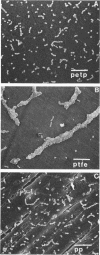Abstract
The adhesion of the oral bacterium Streptococcus sanguis CH3 to various polymeric surfaces with surface free energies (gamma s) ranging from 22 to 141 erg cm-2 was investigated. Suspensions containing nine different bacterial concentrations (2.5 X 10(7) to 2.5 X 10(9) cells per ml) were used. After adhesion for 1 h at 21 degrees C and a standardized rinsing procedure, the number of attached bacteria per square centimeter (nb) was determined by scanning electron microscopy. The highest number of bacteria was consistently found on polytetrafluorethylene (gamma s = 22 erg cm-2), and the lowest number was found on glass (gamma s = 141 erg cm-2) at all bacterial concentrations tested. The overall negative correlation between nb and gamma s was weak. However, the slope of the line showing this decrease, calculated from an assumed linear relationship between nb and gamma s, appeared to depend strongly on the bacterial concentration and increased with increasing numbers of bacteria in the suspension. Analysis of the data for each separate polymer showed that the numbers of attached cells on polyvinyl chloride and polypropylene were higher but that those on polycarbonate were lower than would be expected on basis of a linear relationship between nb and gamma s. Desorption experiments were performed by first allowing the bacteria to attach to substrata for 1 h, after which the substrata and attached bacteria were removed to bacterial suspensions containing 10-fold lower bacterial concentrations.(ABSTRACT TRUNCATED AT 250 WORDS)
Full text
PDF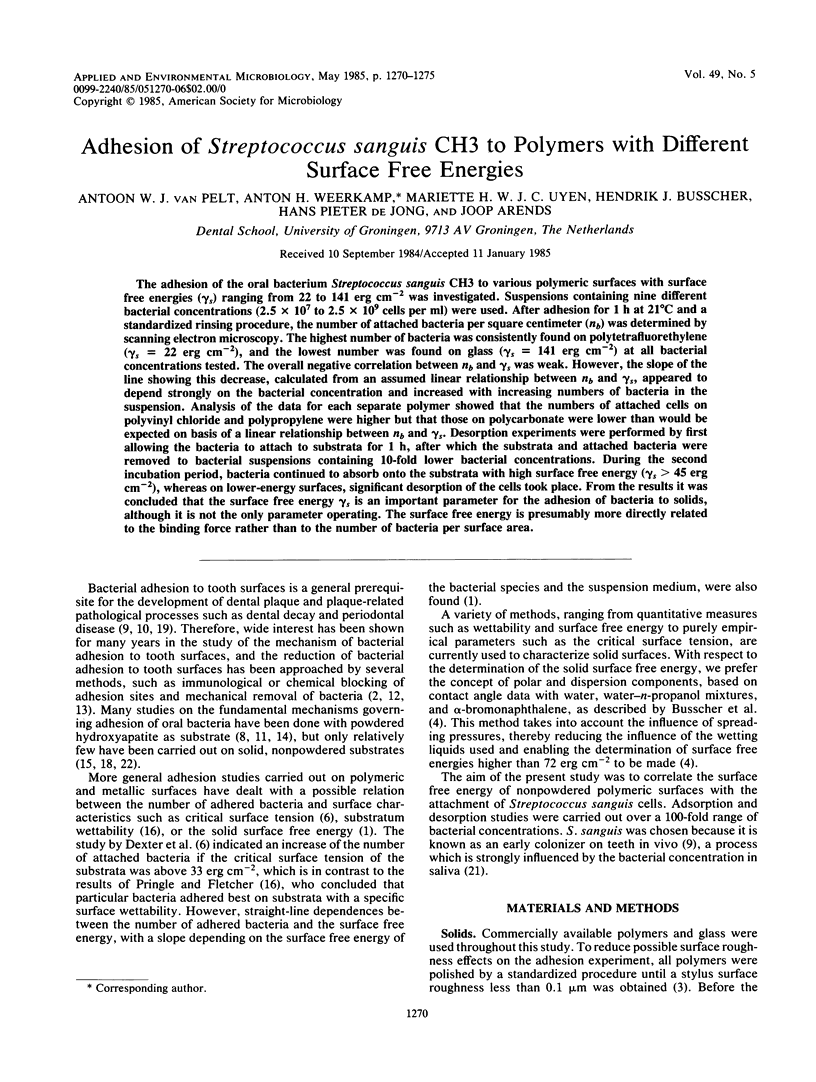
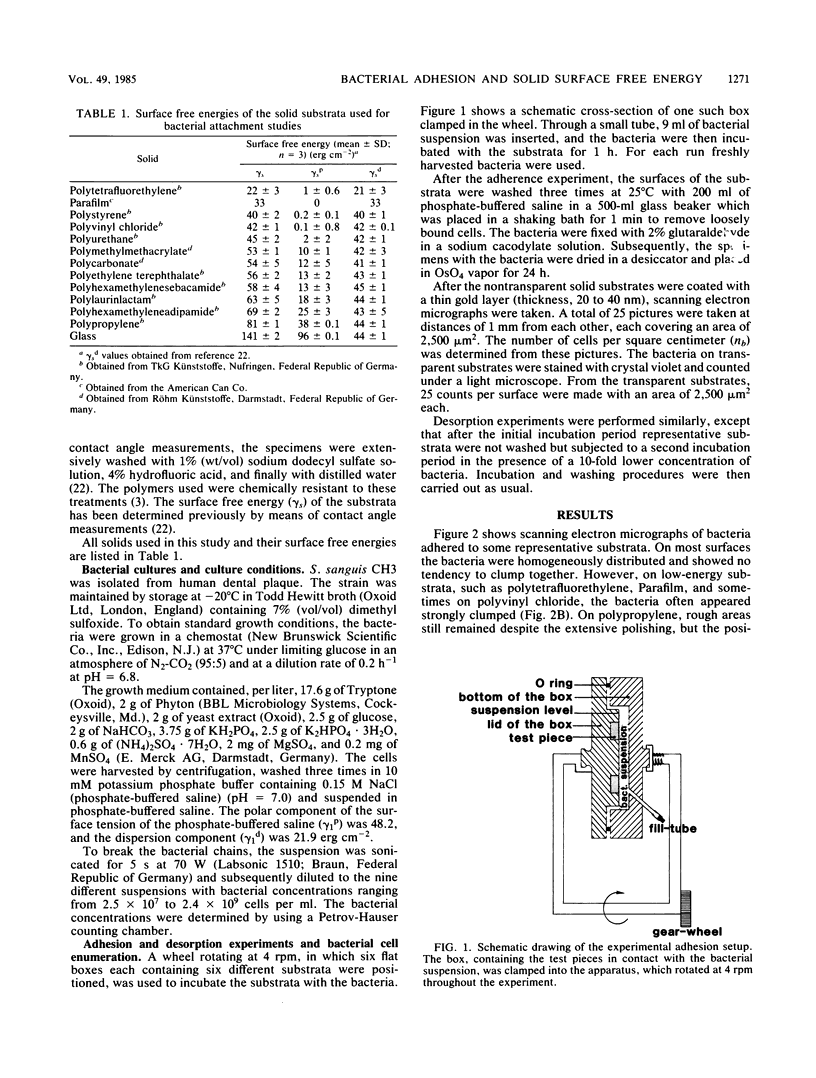
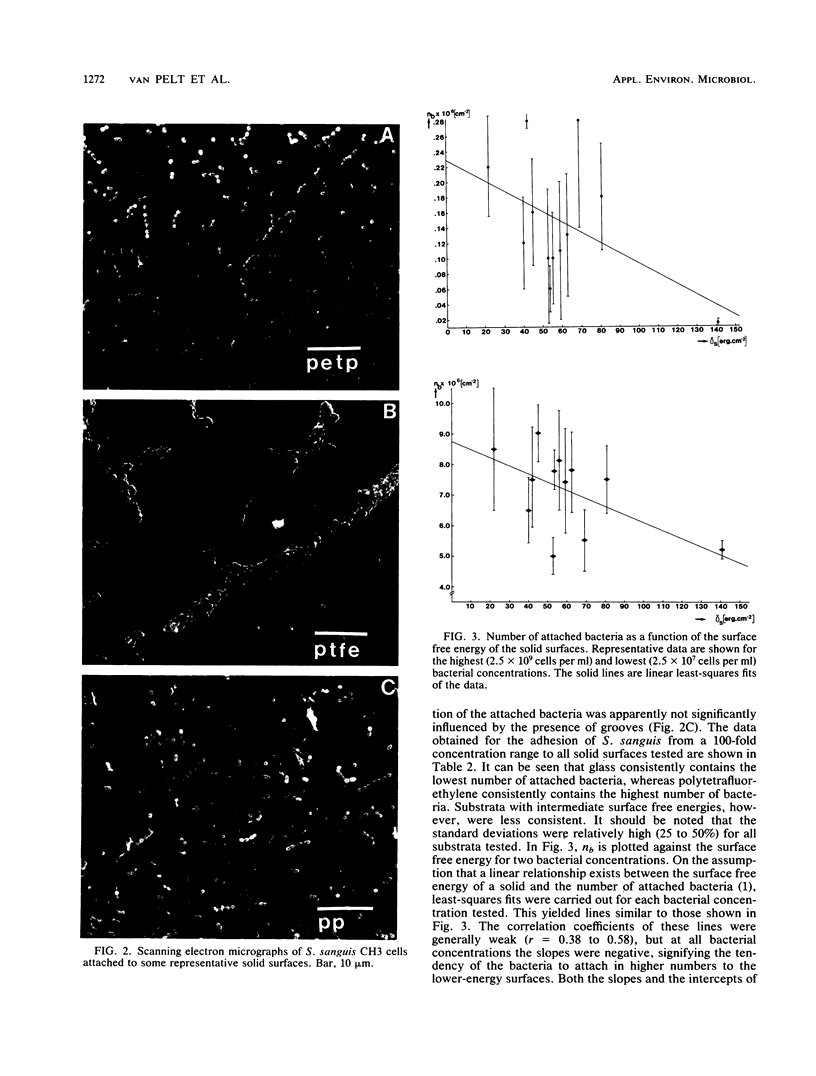
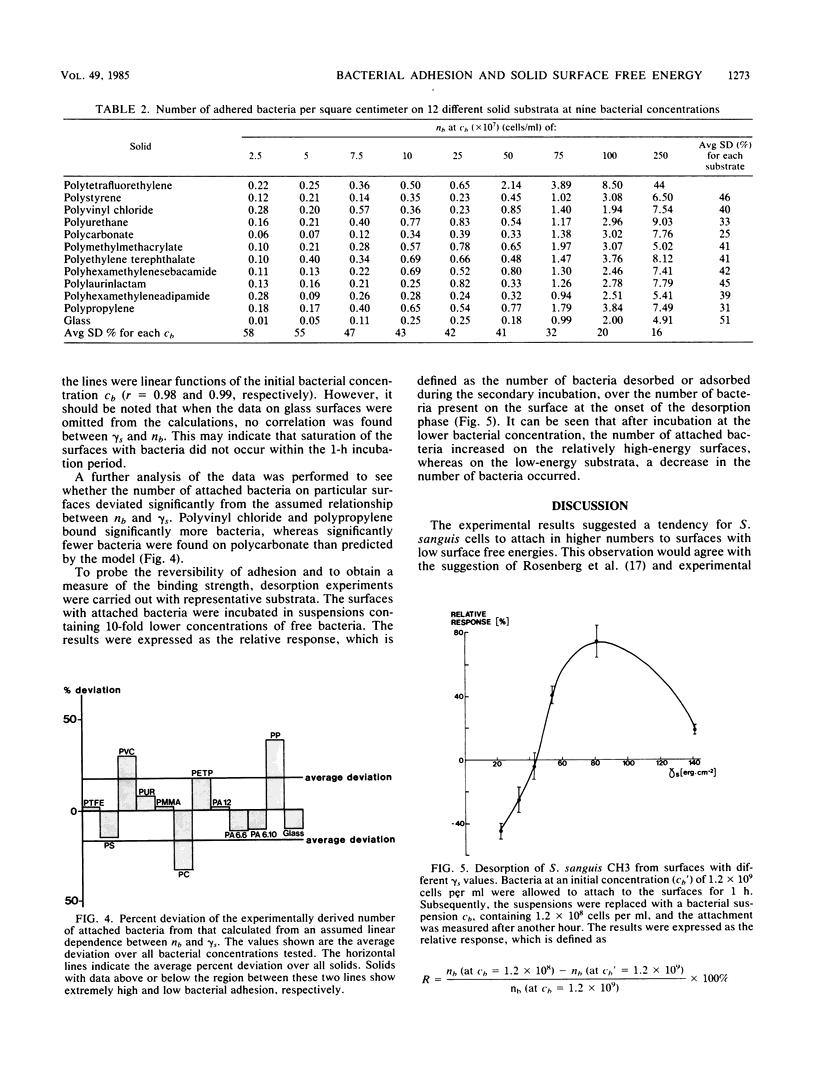
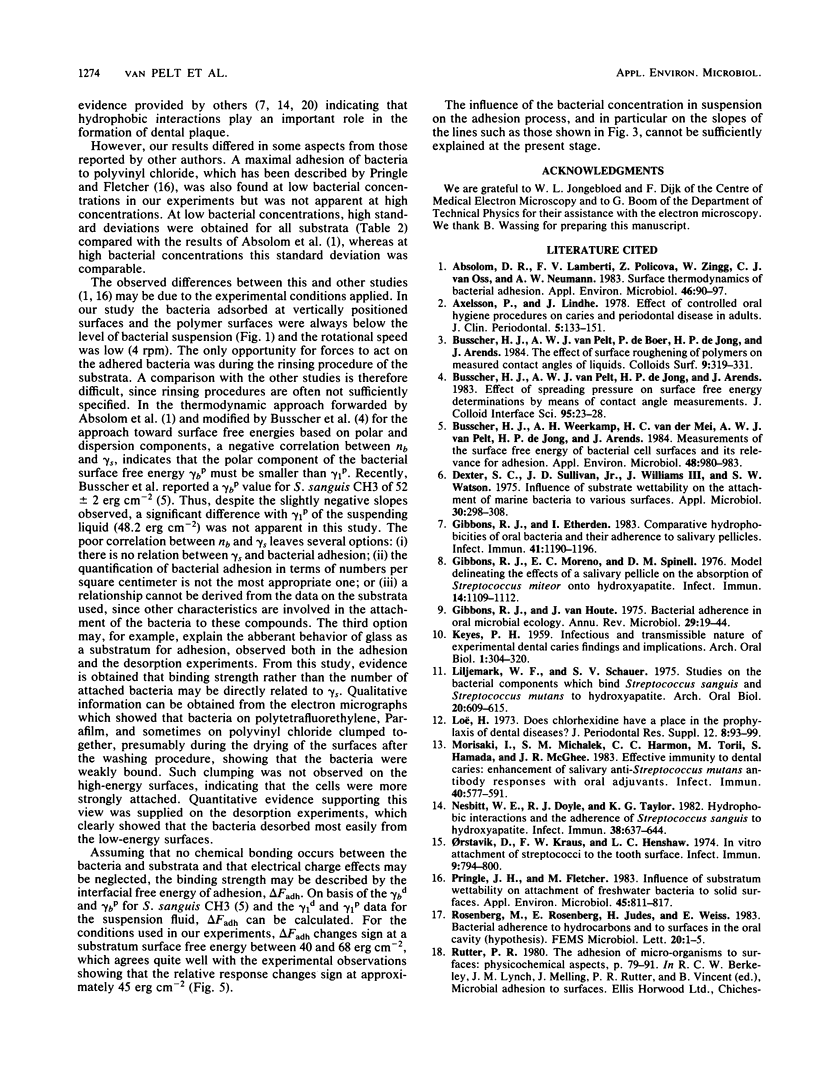
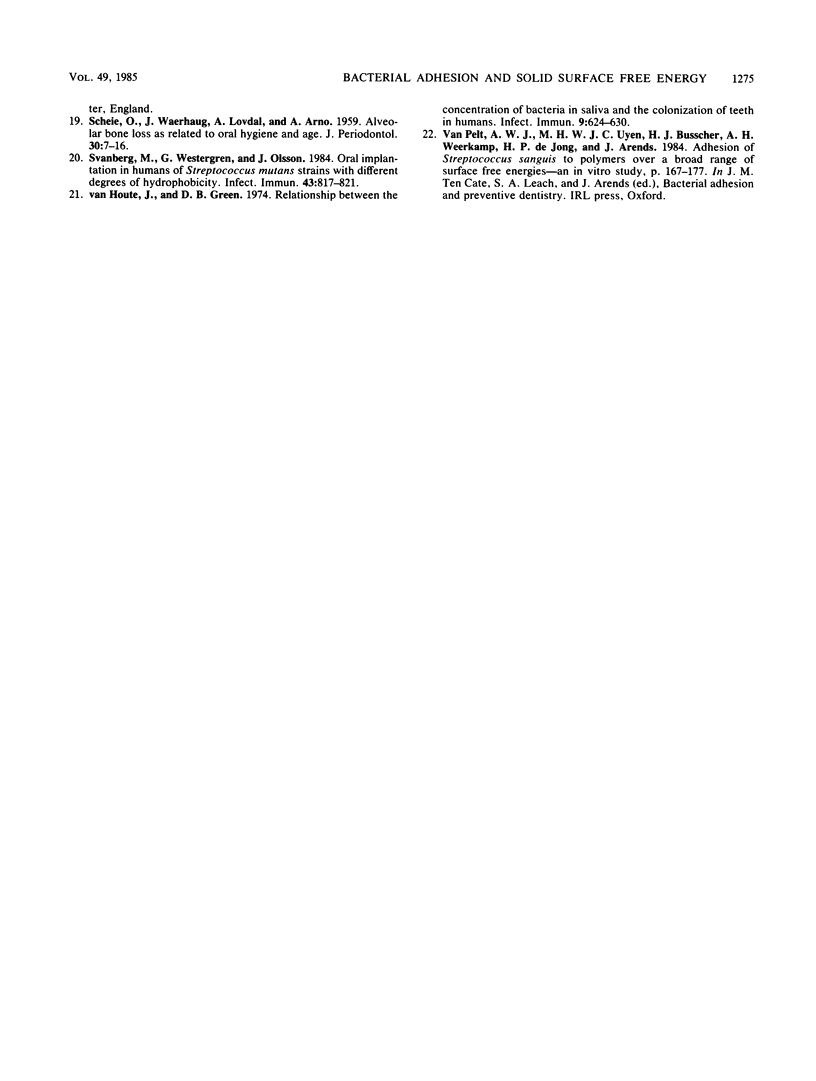
Images in this article
Selected References
These references are in PubMed. This may not be the complete list of references from this article.
- Absolom D. R., Lamberti F. V., Policova Z., Zingg W., van Oss C. J., Neumann A. W. Surface thermodynamics of bacterial adhesion. Appl Environ Microbiol. 1983 Jul;46(1):90–97. doi: 10.1128/aem.46.1.90-97.1983. [DOI] [PMC free article] [PubMed] [Google Scholar]
- Axelsson P., Lindhe J. Effect of controlled oral hygiene procedures on caries and periodontal disease in adults. J Clin Periodontol. 1978 May;5(2):133–151. doi: 10.1111/j.1600-051x.1978.tb01914.x. [DOI] [PubMed] [Google Scholar]
- Busscher H. J., Weerkamp A. H., van der Mei H. C., van Pelt A. W., de Jong H. P., Arends J. Measurement of the surface free energy of bacterial cell surfaces and its relevance for adhesion. Appl Environ Microbiol. 1984 Nov;48(5):980–983. doi: 10.1128/aem.48.5.980-983.1984. [DOI] [PMC free article] [PubMed] [Google Scholar]
- Dexter S. C., Sullivan J. D., Williams J., Watson S. W. Influence of substrate wettability on the attachment of marine bacteria to various surfaces. Appl Microbiol. 1975 Aug;30(2):298–308. doi: 10.1128/am.30.2.298-308.1975. [DOI] [PMC free article] [PubMed] [Google Scholar]
- Gibbons R. J., Etherden I. Comparative hydrophobicities of oral bacteria and their adherence to salivary pellicles. Infect Immun. 1983 Sep;41(3):1190–1196. doi: 10.1128/iai.41.3.1190-1196.1983. [DOI] [PMC free article] [PubMed] [Google Scholar]
- Gibbons R. J., Houte J. V. Bacterial adherence in oral microbial ecology. Annu Rev Microbiol. 1975;29:19–44. doi: 10.1146/annurev.mi.29.100175.000315. [DOI] [PubMed] [Google Scholar]
- Gibbons R. J., Moreno E. C., Spinell D. M. Model delineating the effects of a salivary pellicle on the adsorption of Streptococcus miteor onto hydroxyapatite. Infect Immun. 1976 Oct;14(4):1109–1112. doi: 10.1128/iai.14.4.1109-1112.1976. [DOI] [PMC free article] [PubMed] [Google Scholar]
- KEYES P. H. The infectious and transmissible nature of experimental dental caries. Findings and implications. Arch Oral Biol. 1960 Mar;1:304–320. doi: 10.1016/0003-9969(60)90091-1. [DOI] [PubMed] [Google Scholar]
- Liljemark W. F., Schauer S. V. Studies on the bacterial components which bind Streptococcus sanguis and Streptococcus mutans to hydroxyapatite. Arch Oral Biol. 1975 Sep;20(9):609–615. doi: 10.1016/0003-9969(75)90082-5. [DOI] [PubMed] [Google Scholar]
- Löe H. Does chlorhexidine have a place in the prophylaxis of dental diseases? J Periodontal Res Suppl. 1973;12:93–99. [PubMed] [Google Scholar]
- Morisaki I., Michalek S. M., Harmon C. C., Torii M., Hamada S., McGhee J. R. Effective immunity to dental caries: enhancement of salivary anti-Streptococcus mutans antibody responses with oral adjuvants. Infect Immun. 1983 May;40(2):577–591. doi: 10.1128/iai.40.2.577-591.1983. [DOI] [PMC free article] [PubMed] [Google Scholar]
- Nesbitt W. E., Doyle R. J., Taylor K. G. Hydrophobic interactions and the adherence of Streptococcus sanguis to hydroxylapatite. Infect Immun. 1982 Nov;38(2):637–644. doi: 10.1128/iai.38.2.637-644.1982. [DOI] [PMC free article] [PubMed] [Google Scholar]
- Orstavik D., Kraus F. W., Henshaw L. C. In vitro attachment of streptococci to the tooth surface. Infect Immun. 1974 May;9(5):794–800. doi: 10.1128/iai.9.5.794-800.1974. [DOI] [PMC free article] [PubMed] [Google Scholar]
- Pringle J. H., Fletcher M. Influence of substratum wettability on attachment of freshwater bacteria to solid surfaces. Appl Environ Microbiol. 1983 Mar;45(3):811–817. doi: 10.1128/aem.45.3.811-817.1983. [DOI] [PMC free article] [PubMed] [Google Scholar]
- Svanberg M., Westergren G., Olsson J. Oral implantation in humans of Streptococcus mutans strains with different degrees of hydrophobicity. Infect Immun. 1984 Mar;43(3):817–821. doi: 10.1128/iai.43.3.817-821.1984. [DOI] [PMC free article] [PubMed] [Google Scholar]
- Van Houte J., Green D. B. Relationship between the concentration of bacteria in saliva and the colonization of teeth in humans. Infect Immun. 1974 Apr;9(4):624–630. doi: 10.1128/iai.9.4.624-630.1974. [DOI] [PMC free article] [PubMed] [Google Scholar]



